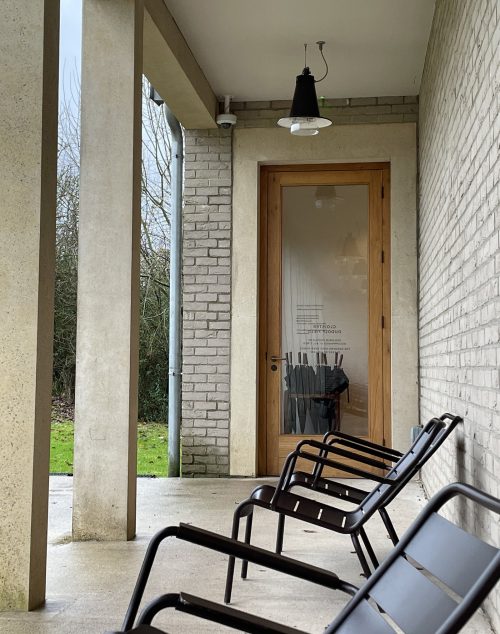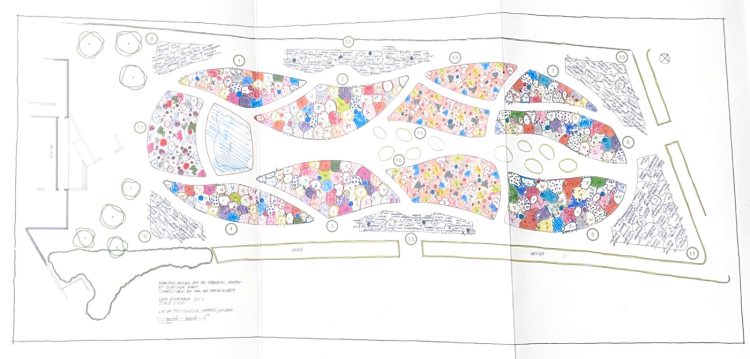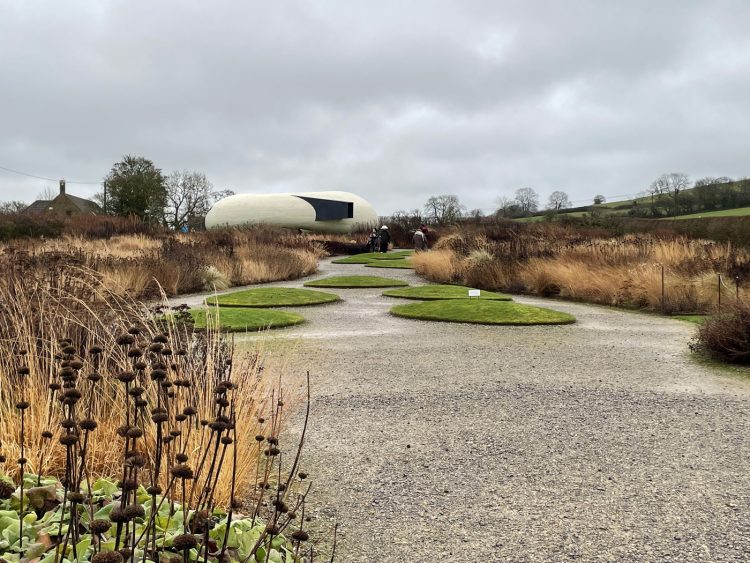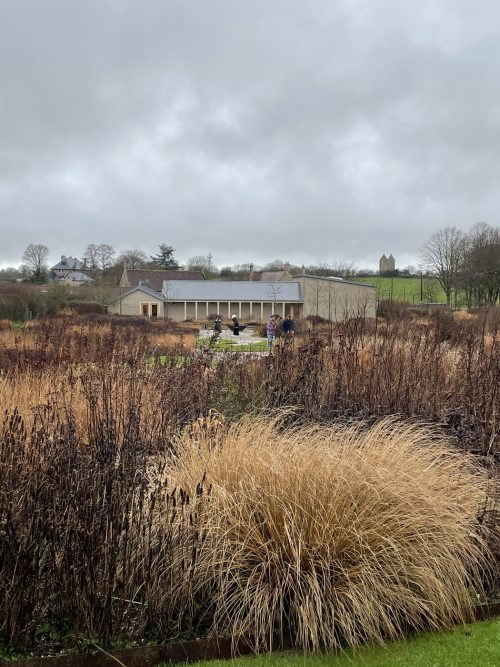"You know what plants will do over time, and what will flower when." - Piet Oudolf
The Oudolf Field in Hauser & Wirth Somerset, UK is a garden designed and operated for enjoyment all year round. Located in the countryside about two hours from London, UK, the weather is unpredictable, with wet weather expected during the Autumn/Winter seasons. These are expected, as there are even umbrellas to borrow, thoughtfully placed just before the door into the garden. The Oudolf Field is designed by Piet Oudolf, a celebrated Dutch garden designer and author. Oudolf is a horticultural celebrity through his recognisable works as a leading figure of the New Perennial movement. The New Perennial movement can be noticed in its prairie-style perennials, limited colour palette, structural plant shapes, as well as the deliberate choice opting to leave the plants as nature intended them to be over winter.

Outdoor seats to enjoy the garden view and umbrellas to borrow before exiting the door. Image by Von Chua.
While Oudolf is well-known in the horticultural industry, his name is known in households in the UK. Since Oudolf’s work was unveiled at the Serpentine Pavilion in 2011 for Peter Zumthor’s dark pavilion structure for the annual summer event by the Serpentine Gallery in London, his works have become widely known by creatives in the UK. This is then strongly followed by his work at the 2012 London Olympic Park, further elevating Piet Oudolf’s name into the general public’s awareness. Widely seen and supported in the UK, the opening of the Oudolf Field in 2014 at the Hauser & Wirth location in Somerset, England is an example of how Oudolf thinks, works and is able to work at various scales.
That people will hang around; they won’t just want to come to the gallery, they also want to be in the garden.
Piet Oudolf’s vision for the Hauser & Wirth Oudolf Field
At the Hauser & Wirth location in Somerset, Oudolf envisioned that gallery visitors would not just want to visit the gallery, but they would also want to be in the garden. During a recent visit this winter to Oudolf Field, indeed, the full charms of the garden are hard to miss. It is small but nonetheless an attraction in its own right to stop by the town of Bruton in Somerset, regardless of what is showing at the gallery. It was a cold and wet winter day, but the weather and muddy ground was not a deterrent to visitors stepping foot into the garden. Visitors arrived at the gallery prepared for the weather - in waterproof gear, braving the light rain with a hood, blissfully walking in enjoyment. As I sat in the external covered walkway, I overheard a young child getting inspired by the scenery of Piet Oudolf’s garden. Although I did not manage to capture the full stanza of this young poet in the making, the young boy said something along the lines of
“Watching the world go by.
The cold, shrill air.
……
Wanting to be blown away.”Anonymous young child
Without Oudolf Field’s encouragement to step out on a winter day in December, the young child will unlikely be inspired. There’s something raw, untouched and genuinely beautiful about allowing nature to find its own beauty and survival. When the season changes, I often see the gardeners swapping large patches of flowers and plants to revive plant beds in the city. Isn’t this raw approach much more meaningful, charming and dare I mention the word ‘sustainable’?
Wide canopied trees have been planted between the gallery and garden to frame the view. The surrounding hedges provide a sense of enclosure, whilst the views of the hills and fields beyond remain visible.
Introductory texts in the Oudolf Field catalogue
With an unmistakably deep understanding of plants, Oudolf’s success and his leading position within the New Perennial movement can be attributed to his ability to envision each garden and its changes through the seasons. Piet Oudolf’s deep understanding of plants did not initially start through an education or a clear career path in gardening. It was through trialling various jobs, he began working at a garden centre. He became addicted and pursued evening school over four years to obtain the qualifications to allow him to build gardens professionally. Frustrated at not being able to source the plants he wanted, Oudolf eventually found a place where he could grow the plants he wanted to find for various projects. Based on Oudolf’s experiences and clear philosophy, coupled with a notable difference in the way in which he envisions and plans for each garden, the result of his works throughout the world is subtly recognisable.

Photo of the original design for the Oudolf Field. Drawing by Piet Oudolf, courtesy of Piet Oudolf and Hauser & Wirth.
Looking through Oudolf’s drawings and research, Oudolf is said to produce detailed drawings - down to the exact number of plants for each spot. With the Oudolf Field, the garden contains over 26,000 herbaceous perennials. The above is a photo of the original design for the Oudolf Field in its catalogue. When one truly understands what a plant and a combination of plants might do over time, and it is not a chance experience, the clarity and determination may be what sets Piet Oudolf’s work apart from other garden designers.

 日本語
日本語 English
English

